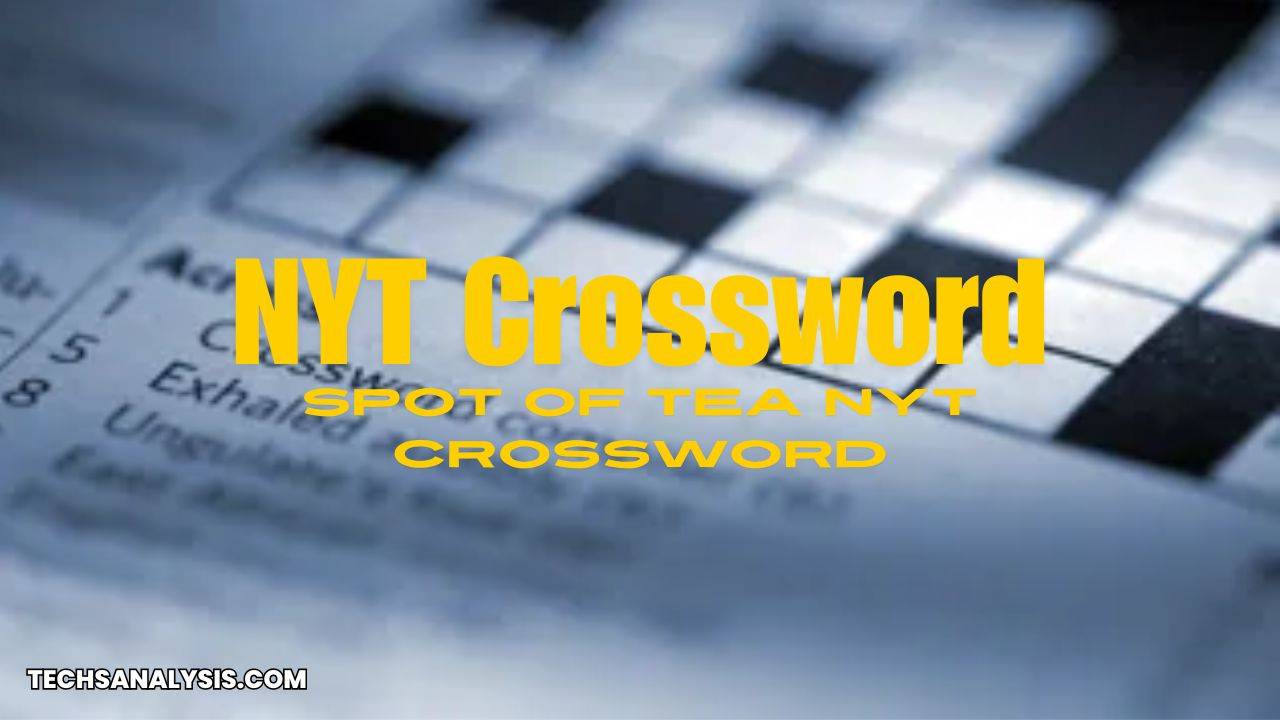Explore the fascinating world of NYT Crossword clues, including “Spot of Tea” and “Lies Around Lazily.” Discover tips, techniques, and the rich history of these engaging puzzles.
The New York Times Crossword is more than just a puzzle; it’s a cultural phenomenon that has captivated solvers for decades. Among the many intriguing clues that solvers encounter, “Spot of Tea” and “Lies Around Lazily” stand out due to their unique nature and the challenge they present. This article delves deep into these specific clues, exploring their meanings, possible answers, and the techniques needed to solve them. Along the way, we’ll examine the rich history of the NYT Crossword, its impact on popular culture, and the community that has grown around it.
Table of Contents
Introduction
Crossword puzzles have been a beloved pastime for many, providing both entertainment and mental exercise. The New York Times NYT Crossword, in particular, is renowned for its clever clues and intricate grids. Specific clues like “Spot of Tea” and “Lies Around Lazily” not only challenge the solver’s knowledge and vocabulary but also their ability to think creatively and interpret clues in different ways. Understanding these clues requires a combination of language skills, cultural knowledge, and sometimes a bit of intuition.
Crossword puzzles are word games that challenge players to fill in a grid of blank squares with words based on clues provided. These puzzles have been a popular form of entertainment and mental exercise for over a century, offering a unique combination of vocabulary, logic, and general knowledge.
History of Crossword Puzzles
The first known crossword puzzle was created by Arthur Wynne and published in the New York World on December 21, 1913. This puzzle, titled “Word-Cross,” laid the groundwork for the modern crossword, although it was initially diamond-shaped and lacked the black squares that separate words. The popularity of crossword puzzles surged during the 1920s, leading to the inclusion of crosswords in newspapers and the creation of dedicated NYT Crossword books.
Structure and Rules
A standard crossword puzzle consists of a rectangular or square grid divided into white and black squares. The white squares are filled with letters to form words, while the black squares separate the words. Clues are provided for each word, typically divided into “Across” and “Down” categories, indicating the direction in which the words should be placed.
Types of Clues
Crossword clues can range from straightforward definitions to complex wordplay. Some common types of clues include:
- Direct Clues: Simple definitions or synonyms.
- Cryptic Clues: Clues that involve wordplay, anagrams, or puns.
- Fill-in-the-Blank Clues: Clues that provide a partial phrase or sentence with a blank space to be filled.
- Abbreviations and Acronyms: Clues that use shortened forms of words.
Benefits of Solving Crosswords
Engaging in crossword puzzles offers numerous cognitive benefits. Regularly solving crosswords can improve vocabulary, enhance problem-solving skills, and increase general knowledge. Additionally, crosswords provide mental stimulation, which can help maintain cognitive function as one ages.
History of NYT Crossword

The NYT Crossword made its debut in 1942, created by the talented editor Margaret Farrar. It quickly gained popularity, becoming a daily ritual for many readers. Over the years, the NYT Crossword has evolved, incorporating contemporary references and reflecting changes in language and culture. It has seen several milestones, such as the introduction of themed puzzles, the inclusion of modern slang, and the adaptation to digital formats.
The crossword’s influence extends beyond entertainment. It has been the subject of academic studies, books, and even movies, highlighting its significance in American culture. Many notable figures, including celebrities and intellectuals, have professed their love for the NYT Crossword, further cementing its status as a cultural icon.
Understanding Crossword Clues
To solve NYT Crossword puzzles effectively, one must understand the different types of clues. Clues can be straightforward definitions, puns, anagrams, or cryptic hints. They can also involve cultural references, idioms, or wordplay. Here are some common types of clues:
- Direct Definitions: These clues provide a straightforward definition of the answer.
- Wordplay: These clues involve puns or playful use of language.
- Anagrams: The answer is a rearrangement of the letters in the clue.
- Homophones: The clue hints at a word that sounds like the answer.
- Cryptic Clues: These are more complex and can combine several types of wordplay.
Spot of Tea NYT Crossword Clue
The clue “Spot of Tea” can be interpreted in various ways, making it a classic example of the creativity and nuance involved in crossword puzzles. Here are some possible interpretations:
- Literal Interpretation: A place where tea is enjoyed, such as a “CAFE” or “TEAHOUSE.”
- Specific Tea Types: It could hint at a type of tea, like “EARL GREY” or “OOLONG.”
- Wordplay: The clue might involve a play on words, requiring solvers to think outside the box.
In historical NYT crosswords, “Spot of Tea” has appeared in different contexts, challenging solvers to consider both literal and figurative meanings. For instance, it could refer to a small stain (“SPOT”) caused by tea, or a cozy place to have tea (“Nook” or “CRANNY”).
Lies Around Lazily NYT Crossword Clue
“Lies Around Lazily” is another clue that can be interpreted in multiple ways. It typically describes leisurely or inactive behavior. Possible answers include:
- Synonyms for Laziness: Words like “LOAFS” or “LOUNGES.”
- Descriptive Phrases: Phrases that capture the essence of lying around lazily, such as “TAKES IT EASY” or “KICKS BACK.”
This clue requires solvers to think about different ways to express laziness and inactivity, making it a fun yet challenging puzzle to crack. Historical puzzles have used this clue to evoke imagery of relaxation and idleness, often requiring solvers to draw on their knowledge of idiomatic expressions.
Techniques for Solving Crosswords

Solving crosswords is both an art and a science. It requires a combination of analytical thinking, pattern recognition, and a broad vocabulary. Here are some effective techniques:
- Start with Easy Clues: Begin with the clues you find easiest to build confidence and fill in some of the grid.
- Look for Common Words: Identify common crossword answers, such as short, frequently used words.
- Use Crossword Dictionaries: These can be helpful for finding obscure words or checking possible answers.
- Break Down Complex Clues: Analyze multi-part clues by breaking them into smaller, more manageable parts.
- Cross-Reference Clues: Use the answers you already have to help with intersecting clues.
Benefits of Solving Crosswords
Engaging in crossword puzzles offers numerous benefits. It enhances cognitive functions, improves memory, and boosts problem-solving skills. Here are some specific advantages:
- Cognitive Benefits: Solving puzzles stimulates the brain, improving memory and cognitive abilities.
- Stress Relief: Puzzles can be a great way to unwind and relax, providing a mental escape from daily stresses.
- Entertainment Value: Crosswords are a fun and engaging way to pass the time, offering a sense of accomplishment with each solved puzzle.
- Vocabulary Building: Regularly solving crosswords can expand your vocabulary and improve language skills.
Famous Crossword Puzzles
The NYT Crossword is known for its iconic puzzles that have left a lasting impact on the crossword community. Some memorable puzzles include:
- Election Day Puzzle (1996): This puzzle cleverly accommodated both “CLINTON” and “BOBDOLE” as possible answers, depending on how you interpreted the clues.
- The Millennium Puzzle: Created by Will Shortz, this puzzle featured clues related to significant events of the past millennium.
- The 50th Anniversary Puzzle: This puzzle celebrated the NYT Crossword’s 50th anniversary with a theme that reflected its rich history.
These puzzles are celebrated for their creativity, ingenuity, and ability to capture the zeitgeist of their times.
Creating Crossword Puzzles

Constructing a crossword puzzle is a challenging yet rewarding endeavor. It involves balancing creativity with technical skill. Here are some key aspects:
- Grid Design: Ensure the grid is symmetrical and balanced.
- Clue Difficulty: Vary the difficulty of clues to cater to a broad audience.
- Theme Coherence: If the puzzle has a theme, ensure all clues and answers fit the theme seamlessly.
- Avoid Obscure Words: Use words that are common enough to be recognized by most solvers.
Successful constructors often share tips and strategies, fostering a collaborative and supportive environment within the crossword community.
Crossword Puzzle Communities
The crossword puzzle community is vibrant and diverse, with enthusiasts connecting through online forums, social media groups, and dedicated websites. These platforms offer solvers the opportunity to share insights, discuss challenging puzzles, and celebrate their love for crosswords. Notable personalities within these communities, such as renowned constructors and avid solvers, contribute to the rich discourse, enhancing the collective knowledge and appreciation of crossword puzzles.
The Future of Crossword Puzzles
The digital age has transformed the crossword puzzle landscape, introducing new ways to engage with this timeless pastime. Online platforms and apps have made puzzles more accessible, while AI and other technologies promise further innovation. Future developments may include adaptive puzzles tailored to individual skill levels, interactive features, and more sophisticated puzzle-solving aids. The future of crossword puzzles looks bright, with ongoing advancements ensuring their continued relevance and appeal.

FAQs
What are common techniques for solving crossword puzzles? Techniques include analyzing wordplay, identifying synonyms, and leveraging letter patterns. Regular practice and expanding one’s vocabulary are also beneficial.
What does the clue “Spot of Tea” typically refer to? “Spot of Tea” often refers to a place where tea is enjoyed, such as a “CAFE” or “TEAHOUSE.” It can also hint at specific types of tea.
How should I interpret the clue “Lies Around Lazily”? This clue usually points to words like “LOAFS” or “LOUNGES,” describing leisurely, inactive behavior.
Conclusion
Crossword puzzles, particularly those in the New York Times, offer a rich tapestry of challenges and rewards. Clues like “Spot of Tea” and “Lies Around Lazily” exemplify the creativity and nuance that make these puzzles so engaging. By exploring the history, techniques, and community surrounding crosswords, solvers can deepen their appreciation and hone their skills, ensuring a lifetime of intellectual enjoyment.

